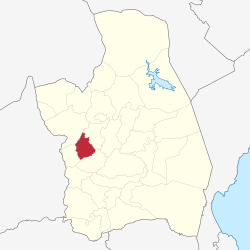Quezon | |
|---|---|
| Municipality of Quezon | |
 Quezon Town Hall | |
 Map of Nueva Ecija with Quezon highlighted | |
Location within the Philippines | |
| Coordinates: 15°33′15″N120°48′40″E / 15.5542°N 120.8111°E | |
| Country | Philippines |
| Region | Central Luzon |
| Province | Nueva Ecija |
| District | 1st district |
| Founded | January 17, 1916 |
| Named after | Manuel L. Quezon |
| Barangays | 16 (see Barangays) |
| Government | |
| • Type | Sangguniang Bayan |
| • Mayor | Mariano Cristino N. Joson |
| • Vice Mayor | Mariano Noriel M. Joson |
| • Representative | Mikaela Angela B. Suansing |
| • Municipal Council | Members |
| • Electorate | 23,438 voters (2025) |
| Area | |
• Total | 68.53 km2 (26.46 sq mi) |
| Elevation | 28 m (92 ft) |
| Highest elevation | 45 m (148 ft) |
| Lowest elevation | 19 m (62 ft) |
| Population (2024 census) [3] | |
• Total | 42,621 |
| • Density | 621.9/km2 (1,611/sq mi) |
| • Households | 10,540 |
| Economy | |
| • Income class | 4th municipal income class |
| • Poverty incidence | 14 |
| • Revenue | ₱ 197.8 million (2022) |
| • Assets | ₱ 529.7 million (2022) |
| • Expenditure | ₱ 156.1 million (2022) |
| Service provider | |
| • Electricity | Nueva Ecija 2 Area 1 Electric Cooperative (NEECO 2 A1) |
| Time zone | UTC+8 (PST) |
| ZIP code | 3113 |
| PSGC | |
| IDD : area code | +63 (0)44 |
| Native languages | Ilocano Tagalog |
| Major religions | Roman Catholic[ citation needed ] |
| Patron Saint | Holy Family |
Quezon, officially the Municipality of Quezon (Pangasinan : Baley na Quezon; Ilocano : Ili ti Quezon; Tagalog : Bayan ng Quezon; Spanish : Municipio de Quezon), is a municipality in the province of Nueva Ecija, Philippines that was named from the 2nd president of the Philippines, Manuel L. Quezon. According to the 2024 census, it has a population of 42,621 people. [5]


